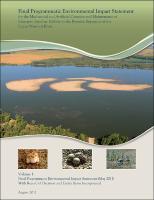Please use this identifier to cite or link to this item:
https://hdl.handle.net/11681/38539Full metadata record
| DC Field | Value | Language |
|---|---|---|
| dc.contributor.author | United States. Army. Corps of Engineers. Omaha District | - |
| dc.date.accessioned | 2020-10-27T13:45:51Z | - |
| dc.date.available | 2020-10-27T13:45:51Z | - |
| dc.date.issued | 2011-08 | - |
| dc.identifier.uri | https://hdl.handle.net/11681/38539 | - |
| dc.description | Programmatic Environmental Impact Statement | - |
| dc.description.abstract | The purpose of the Emergent Sandbar Habitat program, a sub-program of the Missouri River Recovery Program, is to support self-sustaining least tern and piping plover populations on the Missouri River as specified in the recovery plans, by supplementing natural habitat through the mechanical and artificial creation and replacement of ESH. It is specifically related to the 2003 U.S. Fish and Wildlife Service Amendment to the 2000 Biological Opinion on the Operation of the Missouri River Main Stem Reservoir System, Operation and Maintenance of the Missouri River Bank Stabilization and Navigation Project, and Operation of the Kansas River Reservoir System, Reasonable and Prudent Alternative IV 2 and RPA IV 3 for the least tern and the piping plover along the Missouri River within the Omaha District boundaries. This includes ESH within the riverine segments, the reservoirs and other potential areas (e.g. off channel). This Final Programmatic Environmental Impact Statement analyzes the potential environmental consequences of implementing mechanical/artificial creation and maintenance of ESH on the riverine reaches of the Upper Missouri River (the primary action of the ESH program). These actions are pursuant to the 2003 BiOp Amendment RPA IV 3. The FPEIS allows the public and decision makers from the Corps, USFWS (cooperating agency) and the National Park Service (cooperating agency) to compare impacts among a range of alternatives. The FPEIS is meant to inform the selection of a preferred alternative that allows for the support of tern and plover populations on the riverine segments of the Upper Missouri River through creation and replacement of sufficient habitat in a safe, efficient and cost-effective manner, that minimizes negative environmental consequences. | en_US |
| dc.description.sponsorship | United States. Army. Corps of Engineers. | en_US |
| dc.format.extent | 487 pages / 7.76 MB | - |
| dc.format.medium | - | |
| dc.language.iso | en_US | en_US |
| dc.publisher | United States. Army. Corps of Engineers. Omaha District. | en_US |
| dc.rights | Approved for Public Release; Distribution is Unlimited | - |
| dc.source | This Digital Resource was created in Microsoft Word and Adobe Acrobat | - |
| dc.subject | Missouri River | en_US |
| dc.subject | Sand bars | en_US |
| dc.subject | Aquatic habitats | en_US |
| dc.subject | Stream restoration | en_US |
| dc.subject | Environmental management | en_US |
| dc.subject | Environmental protection | en_US |
| dc.title | Final Programmatic Environmental Impact Statement for the Mechanical and Artificial Creation and Maintenance of Emergent Sandbar Habitat in the Riverine Segments of the Upper Missouri River, Volume 1: Final Programmatic Environmental Statement (May 2011) with Record of Decision and Errata Items Incorporated | en_US |
| dc.type | Report | en_US |
| Appears in Collections: | Environmental Documents | |
Files in This Item:
| File | Description | Size | Format | |
|---|---|---|---|---|
| Sandbar Habitat Creation Missouri River PEIS Volume 1_2011.pdf | 7.76 MB | Adobe PDF |  View/Open |